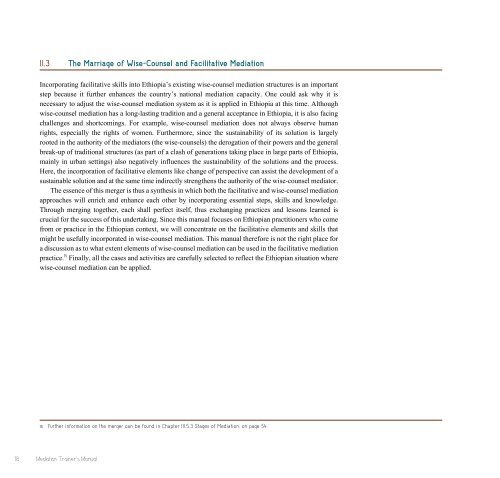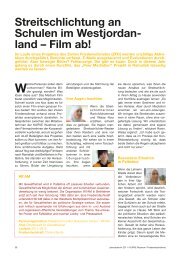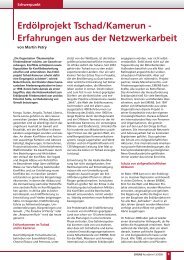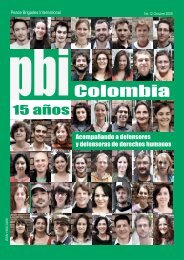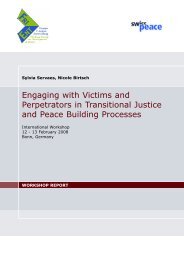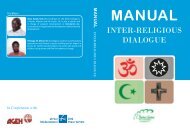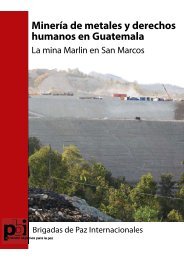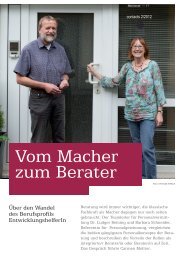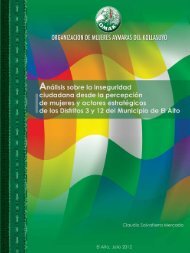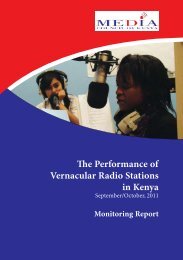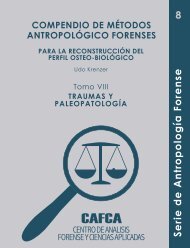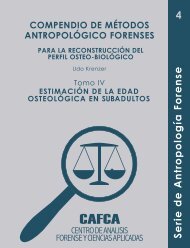Merging Ethiopian Wise-Counsel Mediation and Facilitative ...
Merging Ethiopian Wise-Counsel Mediation and Facilitative ...
Merging Ethiopian Wise-Counsel Mediation and Facilitative ...
- No tags were found...
You also want an ePaper? Increase the reach of your titles
YUMPU automatically turns print PDFs into web optimized ePapers that Google loves.
II.3The Marriage of <strong>Wise</strong>-<strong>Counsel</strong> <strong>and</strong> <strong>Facilitative</strong> <strong>Mediation</strong>Incorporating facilitative skills into Ethiopia’s existing wise-counsel mediation structures is an importantstep because it further enhances the country’s national mediation capacity. One could ask why it isnecessary to adjust the wise-counsel mediation system as it is applied in Ethiopia at this time. Althoughwise-counsel mediation has a long-lasting tradition <strong>and</strong> a general acceptance in Ethiopia, it is also facingchallenges <strong>and</strong> shortcomings. For example, wise-counsel mediation does not always observe humanrights, especially the rights of women. Furthermore, since the sustainability of its solution is largelyrooted in the authority of the mediators (the wise-counsels) the derogation of their powers <strong>and</strong> the generalbreak-up of traditional structures (as part of a clash of generations taking place in large parts of Ethiopia,mainly in urban settings) also negatively influences the sustainability of the solutions <strong>and</strong> the process.Here, the incorporation of facilitative elements like change of perspective can assist the development of asustainable solution <strong>and</strong> at the same time indirectly strengthens the authority of the wise-counsel mediator.The essence of this merger is thus a synthesis in which both the facilitative <strong>and</strong> wise-counsel mediationapproaches will enrich <strong>and</strong> enhance each other by incorporating essential steps, skills <strong>and</strong> knowledge.Through merging together, each shall perfect itself, thus exchanging practices <strong>and</strong> lessons learned iscrucial for the success of this undertaking. Since this manual focuses on <strong>Ethiopian</strong> practitioners who comefrom or practice in the <strong>Ethiopian</strong> context, we will concentrate on the facilitative elements <strong>and</strong> skills thatmight be usefully incorporated in wise-counsel mediation. This manual therefore is not the right place fora discussion as to what extent elements of wise-counsel mediation can be used in the facilitative mediationpractice. 15 Finally, all the cases <strong>and</strong> activities are carefully selected to reflect the <strong>Ethiopian</strong> situation wherewise-counsel mediation can be applied.15 Further information on the merger can be found in Chapter III.5.3 Stages of <strong>Mediation</strong>, on page 54.18 <strong>Mediation</strong> Trainer’s Manual


